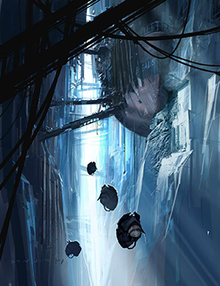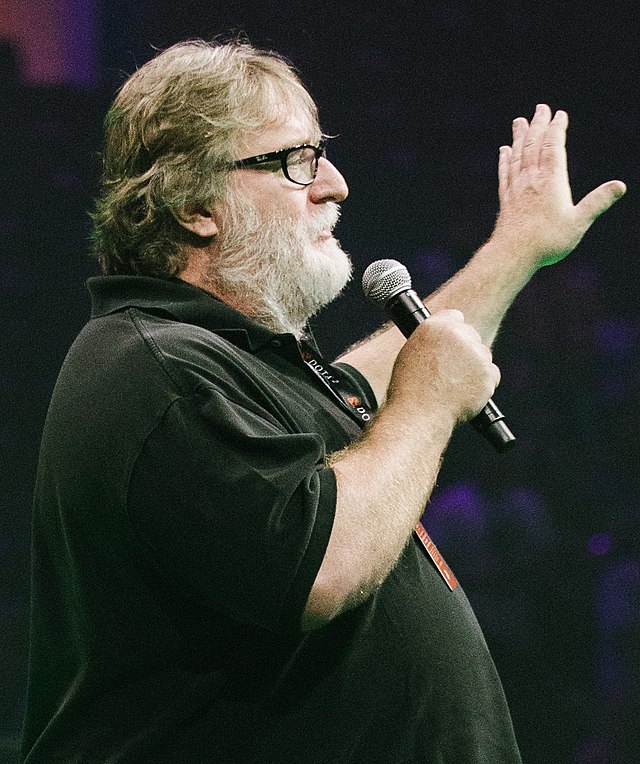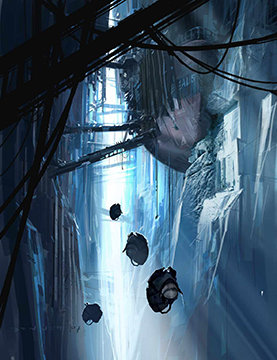Half-Life 2: Episode Three is a canceled first-person shooter game developed by Valve. It was planned as the last in a trilogy of episodic games continuing the story of Half-Life 2 (2004). Valve announced Episode Three in May 2006, with a release planned for 2007. Following the cliffhanger ending of Episode Two (2007), it was widely anticipated. Marc Laidlaw, the writer for the Half-Life series, said he intended Episode Three to end the Half-Life 2 story arc.
| Half-Life 2: Episode Three | |
|---|---|
 Concept art depicting the Borealis | |
| Developer(s) | Valve Corporation |
| Publisher(s) | Valve Corporation |
| Writer(s) | Marc Laidlaw |
| Series | Half-Life |
| Engine | Source |
| Release | Cancelled |
| Genre(s) | First-person shooter |
| Mode(s) | Single-player |
Valve released little information on Episode Three over the following years, and in 2011 Wired described it as vaporware. Valve eventually canceled it, citing a lack of direction and the limitations of the episodic format. They delayed development of a new Half-Life until their new game engine, Source 2, was complete.
Laidlaw left Valve in 2016. In 2017, he released a short story that journalists speculated was a summary of the Episode Three plot. It followed the Half-Life protagonist, Gordon Freeman, as he journeyed to the Arctic and boarded the Borealis, an experimental vessel created by Aperture Science. After Laidlaw posted the story, fans launched several projects attempting to recreate Episode Three. After canceling several further Half-Life games, Valve released a virtual reality game, Half-Life: Alyx, in 2020.
Premise
Episode Three was to be the last in a trilogy of episodic games that would continue the story of the 2004 first-person shooter game Half-Life 2.[1] Episode One was released in 2006, followed by Episode Two in 2007.[2][3]
Valve's president, Gabe Newell, said he considered the trilogy the equivalent of Half-Life 3.[4] According to Newell, whereas the original Half-Life (1998) saw the G-Man transform the protagonist, Gordon Freeman, into his tool, and Half-Life 2 saw Freeman being used by G-Man, the episodes would see G-Man lose control.[4]
Marc Laidlaw, the writer for the Half-Life series, later said he had intended Episode Three to end the Half-Life 2 story arc, at which point he would "step away from it and leave it to the next generation". He planned an ending similar to previous games, with the player character, Gordon Freeman, left in "an indeterminate space, on hold ... So one cliffhanger after another ... I expected every installment would end without resolution, for ever and ever."[5]
Development

Valve announced Episode Three in May 2006, planning to release it by Christmas 2007.[1] Concept art surfaced in 2008.[6][7][8] Valve released little information in the following years; though Valve still discussed Half-Life, there was no clarity on whether further games were coming.[9]
In 2009, reports surfaced that Valve was working with sign language and on a deaf character. Newell said that Gordon's companion, Alyx Vance, had programmed her pet robot, Dog, to use sign language, inspired by a deaf person she had a crush on.[10]
In March 2010, Newell spoke of "broadening the emotional palette" of the Half-Life series, and said the next game may return to "genuinely scaring the player".[11] In 2011, he said: "We went through the episodes phase, and now we're going towards shorter and even shorter cycles ... For me, 'entertainment as a service' is a clear distillation of the episodic content model."[12] That year, Wired described Episode Three as vaporware.[13] In 2017, Business Insider described it as "the world's most anticipated game", but that it had become a "farce".[14]
Valve eventually abandoned episodic development as they wanted to create more ambitious games. According to the level designer Dario Casali, "We found ourselves creeping ever forward towards, 'Well, let's just keep putting more and more, and more, and more stuff in this game because we want to make it as good as we can,' and then we realized these episodes are turning more into sequels."[15] The designer Robin Walker said Valve used Half-Life games to "solve some interesting collision of technology and art that had reared itself". Working on Episode Three, they failed to find a unifying idea that provided a sense of "wonderment, or opening, or expansion".[16] Additionally, Valve had started developing a new game engine, Source 2. As developing Half-Life 2 and the original Source engine simultaneously had created problems, Valve delayed development of a new Half-Life until Source 2 was complete.[15]
"Epistle 3"

Laidlaw left Valve in 2016. He said later that he had tired of the first-person shooter genre and had become "less interested in trying to solve the story problems inherent in a Half-Life style of narrative".[17] In 2017, Laidlaw posted a short story titled "Epistle 3" on his website.[14] The story features characters with names similar to Half-Life characters, such as "Gertie Fremont" for Gordon Freeman.[18] Laidlaw described it as a "snapshot of a dream I had many years ago".[14]
Substituting the characters with their Half-Life counterparts, "Epistle 3" has Freeman and the Lambda Resistance travel to the Arctic to board the Borealis, a ship with extradimensional technology that allows it to erratically travel through time and space, where they confront a myriad of alternative versions of themselves from different timelines.[18] The group seizes control of the Borealis and sets it on a collision course with the heart of the Combine empire. They rig it to self-destruct upon impact, annihilating the Combine's home planet and crippling their forces, but the explosion is not sufficient to destroy the Combine or their Dyson Sphere. Alyx is abducted by the G-Man. Just before the Borealis explodes, Gordon is rescued by the Vortigaunts and transported into the far future, with most of the Resistance dead and the success of their uprising left uncertain.[19][18]
Journalists interpreted the story as a synopsis of what could have been the plot for Episode Three, or for Borealis, another canceled project led by Laidlaw.[20] Walker denied that the story had been Valve's plan for Episode Three, and said that it was likely just one of many ideas by Laidlaw.[21] In a 2023 interview, Laidlaw said the story was not representative of Episode Three, as "all the real story development can only happen in the crucible of developing the game". He said he regretted publishing it, as it had created problems for his former colleagues at Valve, and that he had been "deranged" and "completely out of touch" at the time.[22]
Legacy
Laidlaw's "Epistle 3" story triggered a backlash from fans who took it as evidence that Valve had abandoned the Half-Life series. Some review bombed Valve's game Dota 2 on Steam.[23] Project Borealis, a fangame based on "Epistle 3", was announced in November 2018.[24][25][26] The team decided to switch to Unreal Engine due to the lack of updates to Source.[27] Another team began development of Boreal Alyph, which did not follow "Epistle 3" as closely. They stated their commitment to using the Source engine, describing it as a "constant fight" to modernize the graphics due to the engine's lack of user-friendliness or documentation.[27]
After canceling several further Half-Life games, Valve released a VR game, Half-Life: Alyx, in 2020.[28] Walker said the team saw VR as a way to return to the series.[29] Phil Iwaunik of PCGamesN wrote in 2021 that the cancelation of Episode Three may have benefited the legacy of Half-Life 2, citing the lack of cultural impact of Alyx and the "mystery, speculation and melancholy" of an unfinished sequel.[30]
References
Wikiwand in your browser!
Seamless Wikipedia browsing. On steroids.
Every time you click a link to Wikipedia, Wiktionary or Wikiquote in your browser's search results, it will show the modern Wikiwand interface.
Wikiwand extension is a five stars, simple, with minimum permission required to keep your browsing private, safe and transparent.
